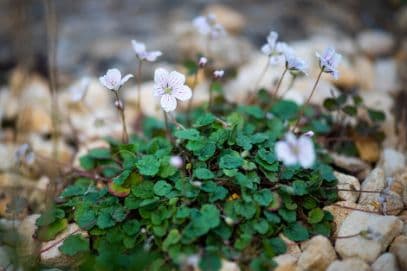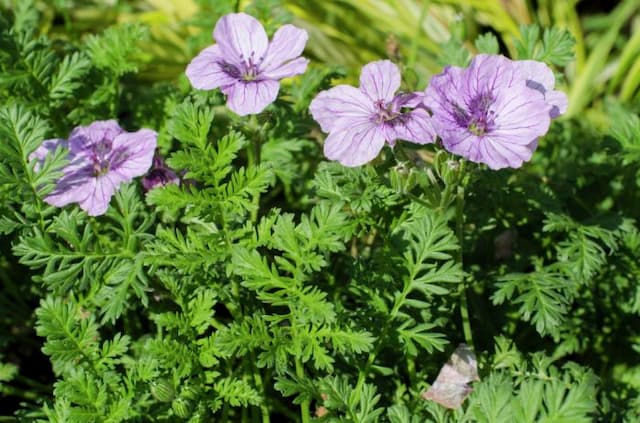Scented Geranium Pelargonium 'Vectis Finery' (Dw/st/d)

ABOUT
Pelargonium 'Vectis Finery' is a stunning plant with vibrant and decorative foliage. Known commonly as geranium, it's recognized for its deeply lobed and serrated leaves that have an intricate pattern. The leaves are typically green, but they often feature contrasting hues such as darker green, bronze, or reddish tones, which can highlight the leaf margins and veins, giving a textured and ornate appearance. This geranium variety is also admired for its flowers. The blooms are arranged in clusters atop slender stems, rising above the foliage like colorful crowns. The flowers can come in various shades, including pinks, reds, purples, or whites, with each individual flower comprising rounded petals that may exhibit a velvety texture. The center of the flowers often has darker markings or contrasting coloration, which adds to their charm and visual appeal. Overall, the Geranium 'Vectis Finery' is a showy plant with a lush, bushy presence, making it a popular choice for gardeners and a delightful addition to flower beds, containers, and ornamental gardens. Its intricate leaf pattern and radiant blossoms create a beautiful display that catches the eye and enhances the aesthetic of its surroundings.
About this plant
 Names
NamesFamily
Geraniaceae
Synonyms
Vectis Finery Geranium, Vectis Finery Pelargonium
Common names
Pelargonium 'Vectis Finery'
 Toxicity
ToxicityTo humans
The plant commonly known as Geranium 'Vectis Finery' is not considered highly toxic to humans. However, there can be cases of mild irritation if ingested, such as stomach upset or dermatitis from extensive skin contact. It is advisable to keep the plant out of the reach of children who might ingest it and to wash hands after handling.
To pets
For pets, Geranium 'Vectis Finery' can be more problematic. This plant is known to cause mild to moderate toxicity in animals like dogs and cats. If ingested, pets might exhibit symptoms such as vomiting, depression, anorexia, and dermatitis. Cats may also display ataxia. It is recommended to prevent pets from chewing on this plant and to seek veterinary care if ingestion is suspected.
 Characteristics
CharacteristicsLife cycle
Perennials
Foliage type
Deciduous
Color of leaves
Varies
Flower color
Mixed
Height
1 foot (30 cm)
Spread
1 foot (30 cm)
Plant type
Herb
Hardiness zones
Varies
Native area
South Africa
Benefits
 General Benefits
General Benefits- Ornamental Appeal: Offers unique and colorful leaves that can add visual interest to gardens or indoor spaces.
- Low Maintenance: Generally requires minimal care, making it ideal for both novice gardeners and those with limited time.
- Drought Tolerance: Once established, it can survive periods of low water, useful in xeriscaping or drought-prone areas.
- Adaptability: Can be grown in a variety of settings, from outdoor flower beds to indoor pots, adapting well to different environments.
- Pest Resistance: Often resistant to common garden pests, reducing the need for chemical treatments.
- Long Blooming Period: Produces flowers over an extended season, providing a long-lasting display of color.
- Fragrance: Leaves are sometimes aromatic, which can add a pleasant scent to the area where the plant is grown.
- Attracts Pollinators: Flowers can attract bees, butterflies, and other beneficial insects to the garden.
- Compact Size: Suitable for container gardening or small spaces due to its dwarf, sturdy growth habit.
 Medical Properties
Medical PropertiesThis plant is not used for medical purposes.
 Air-purifying Qualities
Air-purifying QualitiesThis plant is not specifically known for air purifying qualities.
 Other Uses
Other Uses- As a natural dye: The leaves and flowers of the geranium can be used to create natural dyes for textiles and art projects offering a variety of shades from greens to browns depending on the mordant used.
- In aromatherapy: Geranium oil, though typically from other species, suggests that Pelargonium 'Vectis Finery' could contribute a similar scent or aid in relaxation when used in oil burners or homemade potpourri.
- As an insect repellent: Certain compounds in the geranium are known to repel insects, making it a potential natural alternative to chemical repellents when crushed leaves are placed around seating areas.
- Culinary decoration: The flowers of 'Vectis Finery' could be used as an edible garnish to add a splash of color to salads or desserts.
- Homemade cosmetics: The petals could be used to infuse oils for homemade lotions or balms, granting a floral scent and use of its astringent properties.
- Crafting botanical paper: Dried flowers and leaves can be incorporated into homemade paper, creating a beautiful and unique texture and design.
- Photography prop: Geraniums make for vibrant and colorful subjects or backdrops in botanical photography due to their eye-catching patterns and hues.
- Teaching tool in schools: The geranium can be used to demonstrate plant growth, blooming cycles, and basic horticultural practices to students.
- As a natural confetti: Dried petals could be tossed at celebrations instead of synthetic confetti for an environmentally friendly alternative.
- In candle making: The flowers can be set into the wax of homemade candles to add visual appeal and a faint natural fragrance.
Interesting Facts
 Feng Shui
Feng ShuiThe Pelargonium, commonly known as Geranium, can be used in Feng Shui to promote positive energy and to bring protection and good health into the home. It is believed that placing Geraniums in the South or near the front entrance can create a welcoming atmosphere and harness vital Qi.
 Zodiac Sign Compitability
Zodiac Sign CompitabilityThe Geranium is not used in astrology practice.
 Plant Symbolism
Plant Symbolism- Comfort: Pelargoniums, also known as geraniums, are often associated with comfort and the familiar due to their prevalent use in home gardens and their cozy, welcoming fragrance.
- Healing: The geranium is noted for its healing properties in herbal medicine, symbolizing health and recovery.
- Friendship: Geraniums are sometimes given as gifts to express wishes for happiness or to celebrate a long-lasting friendship, owing to their longevity and resilience.
 Water
WaterFor the Dw/st/d classified plant, commonly known as scented geraniums, watering should be done thoroughly but infrequently. Allow the top inch of soil to dry out before watering again, which will likely be about once a week depending on indoor conditions. The goal is to prevent overwatering and root rot. Provide approximately one-half gallon of water for a standard pot size, ensuring it's applied evenly to the soil until some drains out the bottom, indicating the soil is fully saturated but not waterlogged.
 Light
LightScented geraniums prefer bright, indirect sunlight and should be placed in a spot where they can receive this light for most of the day. A north- or east-facing windowsill is ideal, as direct, harsh afternoon sun can scorch the leaves. If growing indoors, a grow light can supplement natural sunlight if needed.
 Temperature
TemperatureScented geraniums thrive in temperatures between 65°F and 80°F, which are typical indoor conditions. They can tolerate temperatures down to about 55°F during the night but shouldn't be exposed to temperatures below 30°F, as frost can be deadly. The ideal range for robust growth is keeping steady temperatures within the 65°F to 75°F range during the day.
 Pruning
PruningPruning scented geraniums is essential for promoting bushy growth and preventing legginess. Trim back the plant in early spring before new growth starts, removing dead or yellowing leaves and shaping the plant as desired. Regularly deadheading spent blooms also encourages more flowering. Prune the plants every few months to maintain shape and size.
 Cleaning
CleaningAs needed
 Soil
SoilGeraniums such as Pelargonium 'Vectis Finery' thrive in well-draining soil with a pH of 6.0 to 7.0. A mix of equal parts peat, perlite, and potting soil is ideal to ensure proper drainage and aeration. Regular potting mix amended with sand or perlite can also work well.
 Repotting
RepottingGeraniums like Pelargonium 'Vectis Finery' should be repotted every 1 to 2 years. Choose a pot that is slightly larger than the current one, generally in the spring before the growing season begins.
 Humidity & Misting
Humidity & MistingGeraniums, including Pelargonium 'Vectis Finery', prefer moderate humidity levels. They can tolerate indoor humidity levels but perform best when not exposed to high humidity, which can promote fungal diseases.
 Suitable locations
Suitable locationsIndoor
Place in bright, indirect light and water when soil is dry.
Outdoor
Grow in full sun to partial shade, and shelter from extreme weather.
Hardiness zone
10-11 USDA
 Life cycle
Life cycleGermination of Pelargonium 'Vectis Finery' begins with the sowing of seeds, typically in a light, well-draining soil mix, where moisture and warmth trigger the emergence of the seedling. The seedling stage is characterized by the growth of the plant's first true leaves, after which it enters the vegetative stage, during which the plant develops a robust stem and many leaves, and may be pinched to encourage bushier growth. Following the vegetative phase, the plant initiates the flowering stage when daylight and temperature conditions are favorable, producing ornate blooms that the cultivar is known for. After pollination, either naturally or by hand, the plant sets seed, completing the sexual reproduction cycle. In the absence of pollination, the plant continues to bloom periodically. The Pelargonium 'Vectis Finery' typically reaches the end of its life cycle within a few years, as it is a perennial but not long-lived species, after which the plant will die, but can be propagated through cuttings or seeds to continue the lineage.
 Propogation
PropogationPropogation time
Spring-Early Summer
The Pelargonium 'Vectis Finery', commonly known as a type of Dwarf Stellar Geranium, is predominantly propagated through stem cuttings. This method proves to be most effective when undertaken in late summer to early fall. To initiate the process, one must select a healthy, non-flowering shoot. Using a sharp, sterilized blade, a cutting of approximately 4 to 6 inches (10 to 15 cm) is made just below a leaf node. It's imperative to remove all but the top few leaves and any flower buds to focus the plant’s energy on root development. The cutting should then be dipped in rooting hormone powder to stimulate root growth and planted in a mixture of peat and perlite or sand. Providing consistent moisture and warmth, roots should establish within a few weeks, after which it can be potted in growing medium.




![Cranesbill [Blue Sunrise]](/_next/image?url=https%3A%2F%2Fplants-admin.emdemapps.com%2Fimages%2Fplants%2F%2Fimages%2F604b638d45948.png&w=640&q=75)




